#there is a fungus called a bird's nest fungus
Explore tagged Tumblr posts
Text
Science of Bird People
I was speaking to a friend, regarding the comfort of different sleeping positions in avian humans, which led to an infodump on the logistics of bird people and the adaptations they would need to be somewhat plausible. As a certified autistic bird nerd, I feel the need to share my considerations to all of you lovely sex-havers. (Sincerely, an ace.) -----------
1. In order to maintain powered flight, most birds have a bone called a keel, which is essentially an enlarged breast bone for wing/flight muscles to attach to. The logistics of how we would place wings on a human body, which already has shoulder-controlling muscles attaching to the breast bone, is a question unto itself, but considering that bird wings are in fact just a bird’s arms, we can safely assume that a six-limbed modified human, with both arms and wings, would need two sets of pectoral muscles.
-RIP to Scott’s chest dysphoria, but seeing as both male and female flighted birds have keels, I am choosing to believe it causes him no additional dysphoria. (Not from his birdy brain, anyway. Human brain may be another story…)
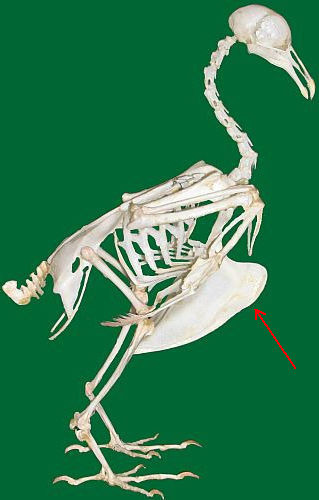
2. Regarding oxygen intake during flight:
True flight is one of the most energy-consuming abilities in nature. To sustain it for any long period of time, flighted birds have several adaptations to help them consume as much oxygen as possible. The first of these, which will be relevant later when considering a reasonable wingspan for a six-foot tall humanoid, are hollow bones. Hollow bones in birds are called pneumatic bones. They are not hollow in the way that a human’s would be if you stripped them of bone marrow; rather, they have “pockets” within them in which air can flow, which helps move oxygen more efficiently through their bodies. Contrary to popular belief, this does not make bird bones lighter or weaker. The bone is denser than in mammals, making them more difficult to break— but this also makes them brittle, more prone to shattering or splintering when significantly damaged, whereas a similarly-sized mammal might only receive a simple fracture.

Additional information, less relevant to Scott’s external anatomy and durability, purely for additional context of how the bones themselves “breathe”; therefore, this is an optional read:
The energy expended during powered flight is exponential, so oxygen needs to be flowing in at the same rate that carbon dioxide leaves. Air sacs connected to relatively small lungs help maintain that unidirectional, constant air flow, to provide the large amount of oxygen birds need to consume in order to fly. The hollow spaces of a bird's bones connect to these air sacs. Oxygen exchange does not happen in the bones or in the air sacs, but it does offer more space for air to be stored, giving them a greater overall lung capacity.
The actual process is quite difficult to explain in a quick summary, but if you know about “circular breathing” in humans, it’s almost similar, in the sense that air is moving around even while breathing in or out— though of course, the actual process is more complex than just pushing air out through cheeks.
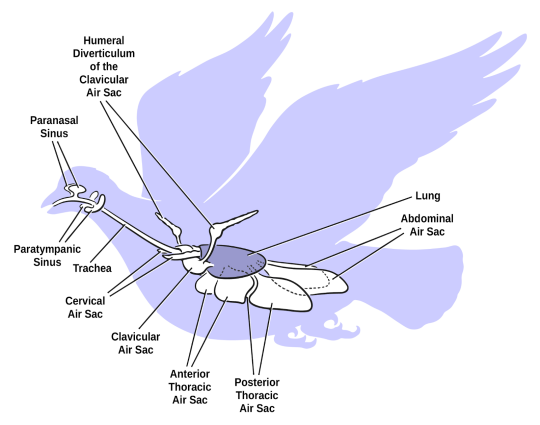
3. Wingspan
The most important thing to consider about wingspan is an animal’s weight. In a world with an atmospheric density similar to earth, there is no chance that a bird as large as Scott would be able to take off, especially considering the added feather weight. Large birds such as waterfowl and vultures already struggle quite a bit.
However, that said, this is fantasy. We can pretend it has a denser atmosphere and/or weaker gravitational pull, and beyond that we can simply suspend our scientific disbelief.
We’ve established that Scott’s hollow bones would not make him lighter. Therefore, we can assume he weighs about the same as any other six-foot tall humanoid (ignoring added weight from extra limbs and massive feathers for simplicity), and his wingspan therefore would not need to be larger than any bird proportionally the same. This is true even if we pretend that his bones would not be hollow, more similar to that of a mammal’s.
Barn owls are normally about 13-16 inches in length, with wingspans between 39 - 49 inches wide.
A small, 13-inch-long barn owl might have a wingspan close to 39 inches— three times that of the body’s length. If we assume the same is true of Scott, then his wingspan may be up to 18 feet long, with each wing measuring close to 9 feet.*
*Note: a bird’s length is typically measured from the tip of its beak to the end of its tail feathers. Scott may or may not have tail feathers, as discussed later in this post, but he does have meaty human legs which may create more weight and drag. It is well-worth considering that his wings may be even larger to overcompensate for the lack of a tail, in order to create that lift he’s missing otherwise.
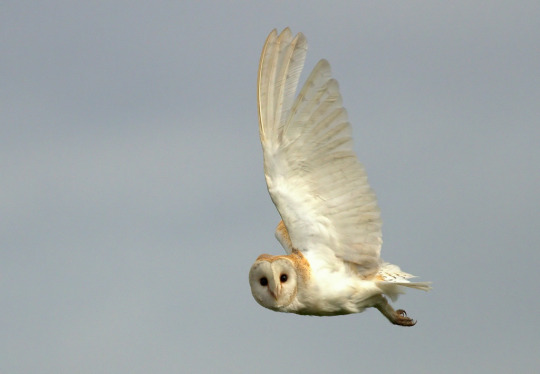
4. All this raises the question of how Scott could possibly maintain all of his feathers.
There are several steps to preening and maintaining feathers. Some are simple, such as simply shaking, raising, and ruffling feathers to get them all in place, but other steps are far more complicated and time-consuming, while being vital to a bird’s survival.
Scott, entering this new world where even breathing is different, would have had to go through a period of not only learning how to maintain his feathers, but also coming to terms with having to set aside potentially hours every single day for that purpose.
Real birds have an oil-secreting gland at the base of their tail. They collect the oil with their beaks to spread it through their feathers.
There are a few ways a humanoid avian might do this, such as collecting the oils from a special gland with their hands and spreading it through their feathers, but I’d lean toward the assumption that there is an oil he has to or can choose to buy, and specialized combs to help spread the oil evenly over each feather.
By himself, going over each individual feather might take hours, so this could be a great way to bond with friends who help him, especially when it comes to feathers at the back of his wings that he can’t reach with his sad human arms and short, inflexible human neck.
Along with learning to keep the feathers tidy, he also has to keep them clean. Shaking and oiling them would be required for daily maintenance, but as an owl, if he gets his feathers wet, he will be far too heavy to fly until they fully dry. If he gets them covered in mud, it might take weeks to get it out.
Owls, if you don’t already know, have “hairy” wings that help muffle sound during flight. The bottoms of the feathers are rigid, but the ends of each wing and tail feather are fuzzy to allow air to pass by without a sound, and the top of each feather also has a unique layer of “fuzz.”
Whereas most birds have some amount of water resistance and may be able to fly in the rain, an owl’s feathers make them uniquely vulnerable during wet weather, unable to fly in the rain.
(Consider the vulnerability Scott must feel when it rains, particularly during adverse weather. Consider the angst potential, whether it’s during his adjustment to his new body; or his desperation when his friends forget he can’t fly in the rain, assuming he’s right behind them or somewhere overhead, while fleeing an enemy during a storm. Imagine Scott crying out for help as someone grabs and binds his wings, but his friends can’t hear him over the downpour.)
I had it in my notes for writing this page to also mention pin feathers and blood feathers. My ramble about feather maintenance was pretty long-winded as-is, so you’ll be spared… This time.
TLDR: Feathers as disability (in towns that are not tailored to avian, or even owlish-specific, races)
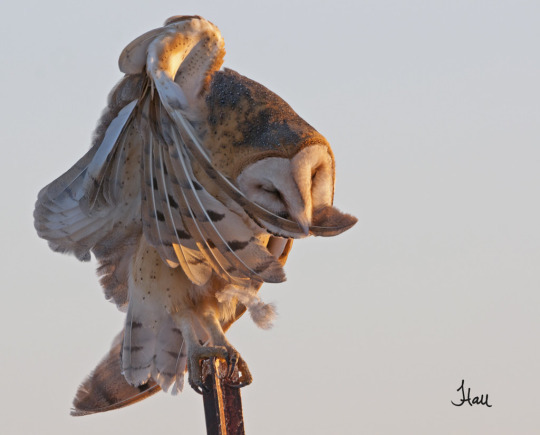
5. Tail Feathers!
I find it very difficult to imagine a humanoid (and therefore upright-walking) owl with tail feathers. How do they keep them from dragging on the ground and being useless? Do they have a different way of steering and controlling flight? Are their tails just incredibly perky? How does that work?
I have nothing to say here except to point out how important it is to have some way to steer flight. Think of Toothless from HTTYD. Can’t fly without the tail fins, and for good reason.
Bats control flight by having extra long fingers, but feathered wings don’t have those extra joints and feathers aren’t as maneuverable as skin.
Artists, I’m looking at you. Give me your wildest theories and ideas, if he doesn’t have tail feathers (or how we’d make that work). I can envision some horrible and beautiful alternatives. Please ask me for my ideas; I have so many.

(A perky tail is the most simple solution to Scott's tail problem-- funny, but we can be more creative.)
Ask me about Scott’s sleep habits and the logistics of that with extra and feathered limbs! Ask me about the weird ways he’d have to land after flying, particularly at high speeds, and whether or not that might cause joint issues over time! I have so many thoughts and notes that I was info-dumping onto @imfindingsolace, but not all are relevant to his physical anatomy as discussed here. [I want someone to make a meme that just says "GET AUTISMED" in a way that feels or looks like you're being punched with autism. Pretend that image is here to finish off this post.]
#the encounter table#the encounter table podcast#tet pod#scott travis#autistic bird nerd certified#not an expert#barn owls my beloved#birds are so freaking cool man#there is a fungus called a bird's nest fungus#which isn't relevant but I thought you should know#avian humans#speculative biology#felt cute might delete later
28 notes
·
View notes
Text
Treasure Hunt 2:
An alternate list for wherever it isn't springtime, at least not like we have it here. This list is more general because it has to serve for both tropical and non-tropical places.
Once again, do as much or as little of the treasure hunt as you want. This is just for fun and awareness. Feel free to add your own things or to include someone else so you can compare notes. You can read over the other list, the spring list, and add anything from it that works, especially the insect part. Posting pictures or descriptions of any of this and tagging #Treasure Hunt is optional of course. The main thing is the looking! Try to get out on one sunny day unless you're somewhere too hot. 1. Plants a. Look for 3 different kinds of plants: vines, trees, grasses, others. If it's winter, are there plants that are still green? b. Find 3 plants in bloom or that have seeds or seed pods still attached. Sometimes even in winter when plants look dead you can still see their seed pods. Seed pods are a whole interesting thing in themselves. c. Find 3 small hard-to notice plants, like moss or tiny plants in cracks in sidewalks or walls. You can include lichens which aren't fully plants or just leave the plant kingdom altogether and include a fungus or mushroom.
Plants bonus points:
a. Notice leaf shapes. Find 3 completely different leaf shapes. Don't touch a leaf unless you know it's safe to touch! Examples of differences might be leaves with wavy or zigzag edges, heart-shaped leaves, or leaves with divisions in them and so on. If you can, find out what kind of plant they're from.
b. Sketch a plant or plant part you think is interesting.
c. Is there a plant around you with a fragrance or strong smell? It's okay to find out from someone who knows more about plants than you do.
2. Birds a. Notice 3 kinds of birds, like a songbird, and a water bird like a duck and either a stalking bird like a heron or sandpiper or a hawk or eagle.
b. Listen and see if you can distinguish 3 separate bird songs or sounds.
c. 3 different times over the next couple months choose a bird and watch what it's doing. Is it eating, if so, is it seeds on the ground, insect eggs in a tree trunk? Or is it chasing another bird? Carrying nest materials? Feeding a young one? Or something else?
Bird bonus points:
a. Using Merlin or just on your own get to know what bird goes with what song, do 3 if you can. Get it to the point that when you hear that song you know which bird is there. If you already know some, try to learn new ones.
b. Notice where birds spend their time: notice one kind you usually see on the ground, one kind you usually see in trees and one kind, if your area has them, that you usually see zooming through the air, most often swifts or swallows. Do you have those in your area?
3. Animals
3 animals, any animals. They're things like Pokemon but in the real world. lol Rats count.
4. Water
Find 3 out of the following (5 is even better):
Fog
Stream
Pond or lake
Icicles
Puddle
Waterfall
Dew
Rain
Snow
5. Make a point of looking at one beautiful sunrise or sunset
6. Stand in 3 kinds of places, for example by a stream or river, high on a hill, in a field or plaza, or in a woodland. Try to notice some nature thing there that most people wouldn't notice. You can, because you're awesome. 7. Directions
This one is simple: if you haven't before, find out which direction each wall of your home faces. If you have a favorite outdoor place, find out where each direction is there. Turn and face north for a moment.
8. Night sky
a. Two weeks apart notice the phase of the moon. If less than half of it is bright it's called a crescent moon. If more than half it's said to be gibbous. If it's within 2 weeks before full moon it's said to be waxing, if it's in the 2 weeks after full moon it's waning. It's okay not to know when full moon is each month but if you do you can say for example, look it's a waxing gibbous! Which is fun.
b. Notice some stars or a constellation. Do you know any? Can you find someone to show you one?
c. The brightest "stars" are often planets. Venus and Jupiter are brighter than any stars. Bonus points for finding out online or from someone who knows where one of those two is and seeing it in the night sky. d. If you're super lucky and far from the equator, maybe aurora!
Have fun! Who knows, maybe the earth likes when you pay attention. ¯\_(ツ)_/¯
#treasure hunt#worldwide treasure hunt#geopsych treasure hunt#what's the most beautiful thing you saw?#i want to add a read more link in the first third but can't get it to work
112 notes
·
View notes
Text
Word List: Honey
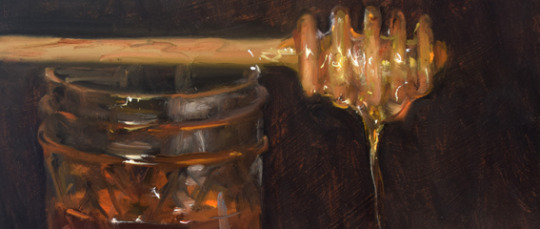
beautiful words with "honey" to sweeten your next poem/story
Honeybee - a honey-producing bee (genus Apis of the family Apidae)
Honeybell - a citrus fruit that is a hybrid between a tangerine and a grapefruit and that has a reddish orange rind and orange pulp and a prominent, rounded neck giving it a bell-shaped appearance; also called Minneola tangelo
Honeyberry - the fruit of either of two trees having sweetish berries: an Old World hackberry (Celtis australis), or genip
Honeyblob - gooseberry
Honeycomb - to penetrate into every part; subvert, weaken
Honeycreeper - any of numerous small bright-colored oscine birds (especially genera Cyanerpes and Chlorophanes) of tropical America; also: any of a family (Drepanididae) of often colorful oscine birds found only in Hawaii
Honeycup - sensitive pea
Honeydew - a saccharine deposit secreted on the leaves of plants usually by aphids or scale insects or sometimes by a fungus; also: a pale smooth-skinned winter melon with sweet greenish flesh
Honeydrop - a drop of honey or something like a drop of honey in sweetness
Honeyeater - any of a family (Meliphagidae) of oscine birds chiefly of the South Pacific that have a long extensible tongue adapted for extracting nectar and small insects from flowers
Honeyflow - a supply or period of availability of floral nectar suitable for bees to convert into honey
Honeyguide - any of a family (Indicatoridae) of small plainly colored nonpasserine birds that inhabit Africa, the Himalayas, and the East Indies and that include some which lead people or animals to the nests of bees
Honeying - to speak ingratiatingly; to flatter
Honeyless - lacking honey
Honeymoon - a period of unusual harmony especially following the establishment of a new relationship
Honeymouthed - sweet or cajoling in speech
Honeymyrtle - an Australian tree of the genus Melaleuca
Honeypot - one that is attractive or desirable; a substantial source of money
Honeysuckle - any of various plants with tubular flowers rich in nectar
Honeyvine - sand vine
Honeywood - a Tasmanian shrub (Bedfordia salicina) of the family Compositae having white foliage and heads of yellow flowers
If any of these words make their way into your next poem/story, please tag me, or leave a link in the replies. I would love to read them!
More: Word Lists
#word list#honey#spilled ink#dark academia#langblr#booklr#writeblr#writers on tumblr#writing prompt#poetry#poets on tumblr#literature#creative writing#writing inspo#writing ideas#writing inspiration#words#writing tips#writing reference#writing resources
235 notes
·
View notes
Note
I just saw your reply on a post abt mushrooms and could I ask for some of your favorite mushrooms and some info on them if you so please?
yeah I love talking about mushrooms! I honestly have too many favorites and I could rant forever but here’s a few very cool ones (note it is 2am and I will probably spell some things wrong cause tired):

Hydnellum peckii aka the bleeding tooth fungus, like, she is the moment, beautiful horror movie of a mushroom, we love her, and the droplets have anticoagulant (blood thinning) properties which is v cool, vampire ass mushroom

Jack o lantern mushrooms like Omphalotus olearius are gorgeous orange shrooms that glow in the dark, very Halloween themed, and their bioluminescence comes from the enzyme luciferase which is the same enzyme that fireflies utilize for their glow

Indigo milk caps are gorgeous like, look at that color, and the “milk” (aka latex) they ooze is a gorgeous indigo blue color. They’re also edible!

Cyathus aka birds nest fungi are these really neat tiny little shrooms that have “eggs” that are reproductive structures containing spores. This is my picture of cyathus striatus, they’re about the size of your fingernail and I just think they’re neat!

Clathrus mushrooms are very cool, they smell bad which is why they’re called stinkhorns, here is my photo of the different life stages of a Clathrus columnatus. I just think they look like funky little aliens, and their gross smell attracts insects which help disperse their spores
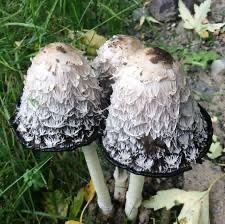

Shaggy ink caps are just gorgeous goth babes, and when they mature they melt into black goo which disperses their spores

This last one isn’t a mushroom, it’s a slime mold, which people often confuse for mushrooms but they’re their own thing. We do however study slime molds in mycology, they get grouped together with fungi. This one is a pic I took of stemonitis splendens aka the chocolate tube slime, I just think she’s gorgeous and wanted to share! A lot of times people will find goo in their backyard and assume it’s a fungus but generally it’s actually a slime mold
25 notes
·
View notes
Text


"Ecologist" means different things to different people. Strictly speaking, an ecologist is a scientist (usually a biologist) who studies the interrelationships between organisms and their environments. "Deep ecologists," on the other hand, may or may not be scientifically trained, and their topic is not ecology per se but rather developing a harmonious relationship with Nature, and defending the Earth against human-generated threats. Scientific ecologists, to the extent that they want to appear respectable, may be quite anthropocentric in their day to day behavior; deep ecologists, on the other hand, are explicitly biocentric (or at least they try to be). To many people, an "ecologist" is simply an environmentalist, or someone who (unlike Hayduke) picks up bottles and cans along roadsides (I've seen garbage trucks labeled "Ecology Dept."). Some self-labeled environmentalists have added to the confusion by misinterpreting what ecology fundamentally means, and using it as a buzzword for various political goals.
More distributing to me, as a professional ecologist sensitive to people's lack of appreciation of ecology, is that environmentalists are often antagonistic toward science and scientists in general, not just toward manipulative science and technology. Some openly suggest that scientists are the enemy, and have nothing positive to offer the environmental movement. For example, in planning a recent Green Conference in Florida, organizers went out of their way to assure that no scientific ecologists were involved. When I criticized the program of the conference (which featured anti-deep ecologist Ynestra King as a keynote speaker) and asked why no ecologists had been invited to speak, the conference organizer responded that if I meant, by "ecologist," the "progressional, biological scientist type," then he saw no need for that kind of person to speak at a conference for activists.
I admit I feel a little uneasy about being called a scientists...somehow that label conjures up images of little men in white lab coats playing with test tubes and DNA. But a woman or man crouched in the forest, keying-out (and admiring) a fungus or recording details of bird behavior, is every bit as much of a scientist as the experimenter in the laboratory. And the lab scientists, too, may contribute invaluable information toward our understanding of how Nature works. I suggest that science phobia is often misguided, and that ecological science is a constructive approach to knowing Nature. By itself, science may be neither necessary not sufficient to understand Nature, but it is one fo the best tools we have. Deep ecologists and other environmentalists would do well to consider more thoughtfully what the Way of Ecology offers, both as a science and as a worldview.
The science of ecology developed from natural history, the lore of Nature. Since Charles Darwin, this lore has been unfused with concepts of interdependence, interrelationship, and co-adaptation—indeed, it was Darwin's thoroughly scientific theory of evolution that made ecology possible. Evolution made sense out of natural history; facts heretofore disconnected became interacting components of general patterns that should be explained in a rational and convincing way. Furthermore, elements in Darwin's theory were empirically testable—the hall-mark of science.
Unlike religious beliefs, scientific hypotheses are designed to be discarded if they no longer accord with observations. Much hogwash persists in science, but honest scientists do their best to weed it out. The subject of ecology is Nature, which has developed in all its beauty through organic evolution and is a vast web of interactions more complex than humans can ever fully comprehend. As ecologist Frank Egler has pointed out, "Nature is not only more complex than we think, but more complex than we can ever think." It is one intricate system composed of a hierarchy of nested subsystems, with structure flowing upward and constraints flowing downward. Although ecological complexity can never (and some would add, should never) be fully quantified, the study of complex interactions—ecology—produces overwhelming respect for the whole in all who approach it sensitively.
In becoming scientific, natural history does not denigrate into mechanism, but rather matured into holism while retaining the proven techniques of mechanistic science. Establishing facts through observation, experiment, and other reductionist methods, ecology unites them and integrates them into broad, general theories, into wholes greater than the sum of their parts. The wholes (theories) are there all along, of course, guiding the collection of data and providing context for facts. As Stephen Jay Gould has pointed out, facts do not speak for themselves, but are read in the light of theory. Perhaps most important to deep ecologists, ecology and evolutionary biology demonstrate unequivocally that humans are just one ephemeral component of an interrelated and interdependent biota. Ecology and evolutionary biology place us firmly within nature, not on top of it.
Natural science is explicitly non-anthropocentric, even though many of its practitioners are still stuck in anthropocentric modes of thought. Scientists, such as Jared Diamond, who have become familiar with taxonomies developed by indigenous cultures (i.e., the way they separate and classify wild organisms into types) are generally impressed by the similarity of indigenous taxonomy to scientific taxonomy. "Primitive" people recognize mostly the same species in Nature as do modern scientists. The differences usually involve those plants and animals that are not used directly for food, clothing, ornamentation, drugs, and other human purposes. These "useless" species tend to be "lumped"; thus, fewer distinctions and fewer species may be recognized by indigenous cultures than by scientific taxonomists. Indigenous people, like everyone else, have a utilitarian bias that has been naturally selected to foster their survival. For this reason, they have developed a taxonomy that is anthropocentric compared to that of biology, which seeks to classify all organisms with equivalent precision, regardless of their utility to humans. This is not to deny that most research money in biology is channeled into anthropocentric research (e.g., medical science and genetic engineering), and that vertebrates and vascular plants have received more attention than "lower" forms.
Ecologists, as scientists, devote their lives to studying, and hopefully understanding, how Nature works. These people love the Earth. As the British entomologist Miriam Rothschild remarked, "For someone studying natural history, life can never be long enough." Other approaches to this same end (or to no particular "end") are also valid, and are not mutually exclusive. Direct experience, contemplation, meditation, and simply the ecstasy of being immersed in wilderness are equally viable approaches and, in fact, provide many ecologists with the inspiration they need to carry on. These spontaneous or mystical experiences are accessible to scientist and non-scientist alike. Nothing in my professional code of conduct as an ecologist says that I cannot run naked and whooping with joy through the desert, or sit all day and stare at a rock. When I am actively engaged in research, of course, these particular activities may not be appropriate, but only because they may bias my results (for example, by scaring away all the fauna). A whole human being is one who is equally comfortable with rational and intuitive-spontaneous explorations of Nature---one who can deal with "hard facts" at one moment and be a wild animal the next. These two approaches, complementary and intertwined as yin and yang, are both essential to holistic understanding.
Aldo Leopold, my favorite deep ecologist, was able to carry his message so powerfully because he had the sensitivity of a poet and the objectivity of a scientist. He communicated in the hard, factual language of science, sprinkled with brilliant, experiential metaphors in the finest tradition of Nature essays. Virtually every faction within the environmental, ecosophical, and resource management fields claims old Aldo for its own, yet few people seem to comprehend the more radical, biocentric notions he developed gradually through his life, and articulated late in his career. Because he could write so damn well and is appreciated by so many people of such divergent worldviews, Leopold provides deep ecologists with an avenue along which to lead others toward biocentric understanding.
If yin and yang, intuition and rationality, emotion and thought, right brain and left brain are complementary, then so too are deep ecology and scientific ecology. It may be that their relationship is mutualistic: they need each other. Don't judge scientific ecology from your experience that most ecologists (or scientists, generally) are anthropocentric jerks. Most philosophers, accountants, lawyers, farmers, and television repairmen are anthropocentric jerks, too. At least ecology, "the subversive science," has a biocentric, holistic underpinning, which cannot be said for most other disciplines. If most scientific ecologists are not deep ecologists, it is because they have yet to grasp the radical implications of their science. If most deep ecologists are not scientific ecologists, then perhaps it would behoove them to explore natural history, evolution, and ecology. You don't need a college degree to be a good ecologist, though it helps, because it compels exposure to the cumulative knowledge of others through textbooks, journals, and symposia. But the best ecology is learned in the field from observation and reflection on why Nature works the way it does; and from just being there, out of doors and away from the human-dominated world.
It is no accident that many ecologists and field biologists are somewhat crude, wild-eyes, and uncivilized, or to put it simply—"earthy." As John Steinbeck, who was trained in zoology, noted in Log from the Sea of Cortez, "What good men most biologists are, the tenors of the scientific world---temperamental, moody, lecherous, loud-laughing, and healthy...The true biologists deals with life, with teeming, boisterous life, and learns something from it." The message of the ecological worldview, in its fullest expression, is this: Get out into the woods, the mountains, the deserts, the swamps. Feel it, explore it, examine it, think about it, understand it. Rational analysis and direct intuition do not conflict—you need both and your brain is built by natural selection to do both. It is your Nature.
If science, in the form of the "new sciences" or ecology, evolutionary biology, and quantum mechanics, is capable of reinserting humans into Nature by enlarging the self to include the whole biosphere—"the world is my body" (Alan Watts)—then perhaps we have come full circle. We began as primitives, relatively un-self-conscious and inseparable from the ecosystem; we evolved into calculating, rational beings, becoming more and more alienated from our real home; we developed other-wordly religions to place us above other life-forms, and dualist reductionist science to ascribe mechanism to all of Nature; but then we developed new forms of science that put us, surprisingly but objectively, right back where we began and where we belong: as Earth-animals.
Most scientists don't want to think (or, at least, talk openly) about such things or feel they cannot do so without jeopardizing their scientific credibility and, therefore, their careers. Jobs and money are scarce for ecologists, and appearing radical or unscientific is usually a one-way ticket to poverty and obscurity. This does not excuse ecologists from active involvement in defending the Earth, but their hesitation is understandable. Deep ecologists must encourage scientific ecologists to get involved in saving that which they study. The battle to defend the Earth needs warriors who specialize in determining what the war is being fought over, what it takes to save what we have, and how we might be able to put it all back together again.
#deep ecology#earth first#anarchism#revolution#climate crisis#ecology#climate change#resistance#community building#practical anarchy#practical anarchism#anarchist society#practical#daily posts#communism#anti capitalist#anti capitalism#late stage capitalism#organization#grassroots#grass roots#anarchists#libraries#leftism#social issues#economy#economics#anarchy works#environmentalism#environment
10 notes
·
View notes
Text
Flames & Asphodel & Elysium & Love
Written for the @strangerthingswritersguild April Fools Day exchange! This was written for @blaqcats-fics using the prompt “Hades/Persephone Retelling with Hades!Eddie and Persephone!Steve, but has like badass bringer of death vibes for Steve.” I hope I brought the badass vibes for Steve lol
Link to ao3
Steve reached out a hand towards a rotting tree and brushed his fingers over the mushrooms growing out of the decaying bark. The tree was long dead, it was a home for insects and fungus. But he knew it had been a home for far longer, the remnants of a birds’ nest in the branches above his head, a hollow containing left behind acorns in the trunk. Even from a sapling it had provided leaves for other creatures. There was a certain nobility to the cycle of life and death. The tree would fall soon, it would decay into the earth and provide nutrients to the plants that would grow from the soil under his feet. It was… “beautiful,” he whispered.
“A dying tree?”
Steve jumped, turning to face the voice. There was a crack in the ground and a figure sitting on the edge of it, watching with intense eyes. “It’s not dying. It’s already dead.”
“…right. I hardly think it’s the most beautiful thing in this clearing.” He smirked and…
Oh, he was flirting. And oh, Steve kind of liked it. “Look closer.” He held out a hand to the stranger and lifted him to stand. “Look at the moss. The mushrooms. The grubs and beetles. When this falls, it will protect salamanders and snakes. It died, yes, but it has yet to fulfill the entirety of its purpose. What could be more beautiful than that?”
The stranger started a moment longer before his expression turned to a wide grin. “You are Persephone. Quite passionate about death, I see.”
Steve’s nose scrunched. “Yes, but please. Call me Steve.” He sighed and looked back at the mossy patch right at eye level for a moment. “Of course I am passionate about death. Life relies on it. It’s everything.” He turned away fully and sighed. “You are…?”
“Hades. But I have a feeling we’ll get a little more cozy, so you can call me Eddie instead.” He rose to his feet and his curls settled on his shoulders after he shook them out. Steve wanted to reach out and touch, arrange his hair artfully to frame his face. He wondered if it was softer than it looked or if it was rigid and unkempt.
“Oh, you assume we’ll see more of each other?”
“A god can only hope.” Eddie gave a sweeping bow and reached out to take Steve’s hand. He looked up through his eyelashes and brushed his lips to Steve’s knuckles. Steve’s heart jumped like he’d been struck by one of Zeus’ lightning bolts.
“I see.” He didn’t want to seem too charmed, not yet. “I think you only like me for my fascination with decay,” he teased. “I am hardly interesting beyond that, especially to a god of such status.”
“And what is it that makes you think I could possibly be uninterested in a beauty like yourself?”
“You are the ruler of the Underworld, an entire realm. Compared to that, am I not… inconsequential?”
“Far from inconsequential my darling,” he purred. “Without death, my realm is inconsequential. Without spring, the fields would not be sown. You are far too important to mortals to even consider yourself inconsequential. You might be everything.”
“Everything?” Steve laughed and covered his mouth to attempt to hide his blush. “You are too much. Too kind, I would think.”
“Too kind? Too kind, he says.” Eddie chuckled, low and warm and it made Steve’s belly feel like a torch in a temple. “I have never been accused of being too kind, neither by mortal or god. I should think you are the kind one.” He looked around the small clearing, grimacing at the dead deer laying just beyond the tree line. “Is there beauty in that too?”
“Of course. Life is cyclical. While the deer’s life is over, it will feed creatures of the woods and sky. It is a home for flies and a feast for vultures. And they too, will meet their end eventually. But we get to observe life over and over again.” Steve’s eyes sparkled as he gazed at the deer and then up at the tree again. “Life is a beautiful thing.”
“I suppose it is.” Eddie was looking right at Steve. “Say, have you ever been to the Underworld? I think I would like to show you what comes after for the mortals.”
“You think?” Steve held out his hand for Eddie to take. “I suppose a look wouldn’t hurt.” He wasn’t smiling. At least, he was trying not to smile. He allowed Eddie to lead him towards the large break in the earth and peered down warily. He couldn’t see much, just the distant flickering of flame. “Are you sure this is safe?”
“Trust me, gorgeous.” Eddie took Steve’s other hand, back to the break. “Just look in my eyes and you’ll be okay.” He took a breath and then yanked Steve forward, pressing their bodies together. Steve stared into his eyes and could hear the way the earth sealed itself above them, could feel hot air rising up as they fell, faster and faster until they stopped.
His feet touched rocky ground and he could hear something panting behind him. Something wet touched the back of his neck and he yelped as he let go of Eddie’s hands and turned around. A great beast stood before him, three pairs of eyes staring and three noses sniffing the air. “Hello there.” He held out a hand and touched the wet nose of the middle head. It sniffed more intensely for a moment before bowing submissively. “Oh, hello.” Steve couldn’t hold back his giggle as he pet soft our, scratching up towards the large pointed ears. “Beautiful…”
“That’s Ozzy.” Eddie grinned and scratched one of the ears. “And these are Judas,” he pointed to the head on the left. “And Maiden.”
“Maiden?”
“Yup.” Eddie opened his arms and grinned as Maiden leaned in and sniffed him. The heads were each as large as Eddie’s torso, but the beast was gentle with him, even with three mouths of sharp teeth and razor-like claws.
“Ozzy,” Steve murmured, grinning when the wet nose pressed against his cheek. “And what does this baby… these babies do?”
“Cerberus is a guardian. Souls try to escape and wannabe heroes try to come and ‘rescue’ them. Cerberus helps keep order. Three heads are better than one, isn’t that right baby?” he cooed to the dog. His massive tail wagged, thudding against the stony ground.
“This is the great Cerberus? I thought he would be… scarier.”
“To mortals, he is terrifying. But he is a sweet boy at his core. He just has to do his job.” Eddie stepped back and wiped drool off his robes. “There is still much to see.”
“I hope everything else is half as exciting as Cerberus.” Steve waved to the beast with a soft laugh. “He is very sweet.”
“The sweetest.” Eddie took Steve’s hand again to lead the way. He was sure footed and almost seemed to glide through his realm, it was like it existed just for him.
Steve supposed it sort of did. Zeus had control of the skies and Poseidon ruled the seas. And Eddie had the Underworld with its rocky ceiling seeming as far away as the sky felt from earth. He’d expected Hellfire and dank air and the screams of the damned, but it was sort of like a well lit cave.
Until they came to a river of fire. “Huh.” He crouched down and reached out to touch the flames. Were he mortal, he’d be burned to the bone in hardly a second, but it was just a tickle to his godly skin. “Wow… nothing lives in there?”
“It leads the way to the deepest pits of the Underworld. For the worst of the mortals, they must traverse through the Phlegethon to reach their eternal punishment. Of course, I don’t dole out the punishments, I simply oversee the order of things.”
“No,” Steve agreed. “You are no master of death.” He rose to his feet and considered Eddie a moment. “Death is not your domain.” He grinned. “It is mine.”
“Harmony.” Eddie offered his hand again and Steve, again, accepted. He liked holding Eddie’s hand. Liked being guided like this. “Without you, my domain does not exist, without my domain, there is no place for souls to continue to. We balance each other, Stevie.”
“I suppose we do.” He walked along the edge of the river, the heat of the flames dying down as they continued further away. Clear water ran near his feet as they entered beautiful fields, full of grass and flowers. Souls milled about, but Steve was more interested in the flowers. “Asphodel?”
“Yeah. This is where most souls come. Those who were not cruel but not exceedingly exceptional. There is peace here.” He began to gather stalks of the flowers and weave them with deft fingers as Steve watched. “The mortals will lay these at the resting place of their loved ones on earth. I think there’s a beauty in it, don’t you?” His tongue poked out as he tied the flowers into a sort of crown.
Steve smiled and reached out, cupping his hands against the flowers. They grew brighter at his touch, bloomed fully and seemed to stand out among the other white flowers. “Yeah. There truly is.”
Eddie reached out to gently lay the crown on Steve’s head. “Come, I’ll show you where the exceptional go. The ones who did the most for the gods and their fellow man. Heroes of legend and the chosen of the mortals.”
Steve’s face felt warm as a late spring’s day as he followed Eddie. He liked the Asphodel crown more than anything he’d ever worn, he thought. It had been crafted by Eddie’s hands, made of something from his realm. He found himself appreciating the realm a little more with each step that he took. He knew death. He knew it well, like a friend. But he’d never seen what came next, had only heard stories.
And he could see the seed of truth in many of those stories, but they failed to mention the good. The way Eddie’s smile lit up his eyes, the way he showed so much care for all that he was surrounded by. Steve even felt cared for by the lilt in his voice, the way his eyes crinkled when he grinned, the curve of his lips when he smiled. He seemed so genuine.
“Are you lonely?” The question slipped out before Steve could think about asking.
“Lonely? Nah.” Eddie looked over his shoulder. “I’m not alone down here. You haven’t even met the furies yet. Red is a real spitfire, I think you’ll like her. And one of Iris’ children is totally infatuated by her, he brings messages all the time, it’s-“
“You are not alone, I see that.” Steve reached out this time and took Eddie’s hand. “But that does not mean you aren’t lonely. I never see you on Olympus. I rarely hear of gods traversing down here.”
Eddie went quiet as they stepped into a golden field filled with a rainbow of flowers. Steve still preferred the asphodel. “I… have never been asked that.”
“No?”
“No. I guess… I’ve never considered it.”
The air was warm like they were under the sun, but Steve could tell the difference. A mortal likely wouldn’t, but he knew the way the sun felt on his skin. Eddie seemed deep in thought and Steve politely looked away, watched as the souls of mortals and living demigods ran through the fields, all seeming so happy. It was beautiful, but he’d rather follow Eddie than stay there.
“I think I might be,” Eddie confessed, voice almost too quiet to hear. “I rule the Underworld, but have few equals here. Few who would choose to be here.”
“And if… I would choose to be here?” Steve stepped closer until he was face to face with Eddie, almost close enough to feel his breath.
“Why would you?”
“It’s beautiful here. I’ve never seen anything like it, I want to see more, to experience more. Tell me, Eddie, where is your home here?”
Eddie’s pale skin looked warm as he looked away, even with the golden light shining down, the blush was clear to Steve. He liked the way it looked on Eddie, the way he tugged at his hair to try and hide it. “I suppose I should show you.”
He turned away from the fields and Steve took his hand as they walked side by side. The palace was in what Steve assumed was the center of everything. It wasn’t lifeless and empty, it was warm and cluttered and so… beautiful. It felt like Eddie.
“I like it.” He looked around with a smile. It felt like home in some way deep inside of him. In a way his mother’s home in Olympus had never felt.
“You- you do? I mean. You do. Of course you do.” He grinned. “Stevie, listen-“
A knock at the door took their attention. It swung open to reveal Lucas, son of Iris and messenger of the gods. “Oh. Hey, that was… easier than I thought.” He gave an awkward wave.
“Max isn’t here, dude. She’s busy.”
“I’m not here for Max. I have been sent by Zeus.”
“Zeus? The fuck does he want?” Eddie’s face scrunched up. Steve wanted to bite him.
“Steve is being summoned. His mother is looking for him. It’s been a whole thing, we should get going. Steve?”
Steve hesitated, looking at Eddie. “If mother is summoning me, I can’t… I have to go.”
“Will you come back?” Eddie’s voice was soft.
“I want to. I do, I want to stay here with you, but I can’t ignore a summons. I don’t know what mother would do, what Zeus would do. I can’t do that to Lucas, he’s-“
“A good kid, I know.” Eddie sighed. “Just wait here. I’ll be right back.” He turned and hurried deeper into the palace.
“…so, Max?”
Lucas looked away, tugging at his robes. “I’ve only met her a few times. In passing. I’m not- it’s not a thing.” He cleared his throat. “…Eddie?”
“Might be a thing. Not sure yet.”
“Huh. That’s cool, man.” He nodded. Another few moments passed in awkward silence. “Is he coming back…? Should we… leave?”
“No, no, he said he’d be back.”
“Cool. Cool.” He rocked on his feet.
Steve breathed a sigh of relief when Eddie came hurrying back. “Sorry, sorry, couldn’t find this, had to look.” He held up a pomegranate, sliced in half.
“Oh.” Steve’s eyes went wide. He knew that eating food in the Underworld bound you there. Everyone knew that, mortals and gods alike.
“You don’t have to, but… this would make certain that you would return to me.”
Steve held out his hands and accepted the pomegranate, digging his fingers into the fruit to remove several seeds. “I will return to you.” He leaned in and pressed a delicate kiss to Eddie’s lips and shoved the pomegranate back into his hands. “I will come back.”
He lifted his hand to his mouth and bit down on several seeds, fingertips sticky with red juice. He could feel them in his gut upon swallowing. “I will see you soon,” Eddie murmured as Steve walked away with Lucas.
On the way back to the peak of Olympus, Steve could taste Eddie and pomegranate on his tongue.
16 notes
·
View notes
Text
Today, we have another fungus! But this one looks very unique! This is Crucibulum Leave, or commonly called the common bird's nest fungus! They cling to little branches and twigs, exactly like a birds nest, and actually look like a bird nest, complete with eggs!
The caps are rather small, growing no more than 10mm across, and start with a velvety cinnamon-yellow membrane over them, called a epiphragm! This eventually bursts, revealing the spore sacs inside, called periodoles, each of which is attached to the cap by a thin string called a funiculus!
The spore sacs use rain to release the spores! The raindrop causes the sacs to jump 4 feet into the air, breaking the string, and spraying spores out as it flies through the air!
Crucibulum Leave is found across the UK, typically on decaying wood, in any kind of woodland, particularly dark and damp ones! They're also found in parks and possibly even your garden, if you have wood chips anywhere, but they're so tiny, it's easy to miss them! Also, the fungus is slightly toxic to us, so don't go out and eat them, but other mammals do nibble on them!
Overall, Crucibulum Leave, or the common bird's nest fungus, is a very unique looking fungus, that loves to digest decaying wood, allowing the carbon cycle to continue! If you liked learning about this fungus, feel free to like and comment, and if you want more in the future, follow my page! Now, without further delay, here it is!

4 notes
·
View notes
Text
Plenty of non-biological poisons have been mentioned. Antifreeze mixed into a sweet drink has killed many murder victims, because antifreeze is sweet. Royalty used to drink out of lead cups because the lead sweetened the drink. They taste sweet out of sheer coincidence.
If you’re talking about a biological poison, I could see a plant developing a tasty poison if it could benefit from the animal dying above its roots and nourishing the ground with its corpse. It would have to be a very fast-acting poison, and it would have to be the kind that makes you calm and sleepy, otherwise the animal would run off to somewhere where it felt safe to be sick or in pain. And it would have to produce enough of the poison to keep the animal there, eating, while the poison starts to work. So, it wouldn’t be a plant that preys on warm-blooded creatures (birds and mammals), because we can get away too quickly and we eat a lot. It might prey on cold-blooded animals, but their metabolism is slower, so the poison would have to be really potent in order to work quickly enough. It would probably be an insectivorous plant, which makes sense because there’s already insectivorous plants irl (Venus fly traps, sundews, pitcher plants). An insect is small enough that a plant could reasonably produce enough poison to keep the insect there while the poison starts to work.
I could also see a mushroom producing poison for small animals (the size of a mouse or gecko), since most of a mushroom is not the part that we call a mushroom, most of it is in the hyphae in the soil. So if a mouse eats some tasty poison that grows in the mushroom, gets spores all over its body, goes home to its little burrow, and dies, that’s beneficial for the mushroom because only a tiny piece of the parent mushroom got eaten (and it can regrow) and now its offspring has a nourishing mouse corpse to eat.
Of course, there would be an evolutionary arms race between the poison plant/fungus and the species it preys upon, since the animals that think the poison is tasty and eat it don’t get to reproduce. So the target species for these poisons are probably eusocial insects like bees and ants, since only the queen produces offspring and the queen never leaves the hive/nest to be tempted by the poison plant (assuming the worker bees/ants don’t live long enough to bring the poison back to the hive/nest).
I have no idea if these kinds of poisons/carnivorous plants actually exist, I’m just telling you the how they could evolve.
okay so like I’m not a fancy science man but I know the reason a lot of poison things taste bad to us is because the ability to recognize when something is poisonous and NOT want to eat it is an evolutionary advantage, but do you think that means that the most poisonous toxic deadly fastest-acting shit in the universe is secretly delicious. Like if it was something that you could never eat twice, only once, and would never accidentally recognize as food.
If there was a substance that killed any living thing within moments of being in your mouth do you think it could taste delicious
936 notes
·
View notes
Text
Week 26 observations
6.25.25

Laughing Gull
Leucophaeus atricilla
Observed most days on Galveston Island. They are native to the area and are a common sight year round. Populations live from North America to South America with so vagrant populations in Europe. Northernmost groups will migrate south for the winter.
They are usually active during the day but during breeding season will also be active at night, busy foraging. They are susceptible to toxins and pollutants since they have a wide range of feeding habitats.
They are monogamous and will stay with the same mate for several breeding seasons. They both build the nest and incubate the eggs. The female will lay a clutch of 2-4 eggs and once the eggs hatch the adults will remove the shells from the nest.
#laughinggull #Leucophaeusatricilla #citizenscience #native #gull #bird #nature #outdoors #june #june25 #2025 #picoftheday #project365 #day176
6.26.25
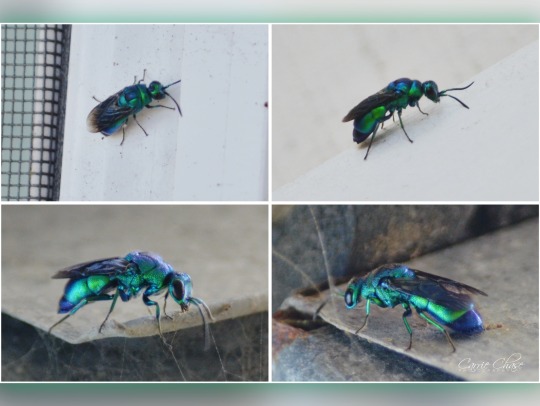
Metallic Bluish-green Cuckoo Wasp
Chrysis angolensis
Observed 6.26.25 at Galveston Island State Park. They are not native but are found worldwide excluding Antarctica. They are invasive but not considered pests since they contribute with pollination.
They are kleptoparasitic meaning they lay their eggs in the nest of a different species of wasp or bee. The cuckoo wasp larvae will eat the other wasp larvae, stored food and eggs. They have also adapted to this by having a hard exoskeleton that protects them from the host insect and some can even mimic the odor of the host insect to better blend in.
The striking color comes from structural coloration that is similar to the indigo bunting in that it has microscopic structures that refract light instead of having pigment.
#metallicbluishgreencuckoowasp #Chrysisangolensis #citizenscience #nonnative #invasive #cosmopolitan #insect #wasp #nature #outdoors #june #june26 #2025 #picoftheday #project365 #day177
6.27.25
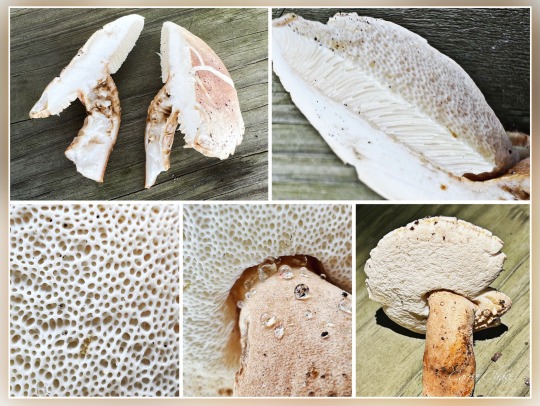
Chestnut Bolete
Gyroporus castaneus
Observed 6.22.25 at Galveston Island State Park. It is native to Europe and the Eastern half of North America, including Texas, but is typically not going to be found on Galveston. It prefers oak trees to thrive and I did find this one under some of the live oaks at the park.
I didn’t get a spore sample on this one but they will leave a pale yellow print.
As it matures the stem becomes hollow and this mushroom does not bruise.
It is edible but again, I’m a novice so I’m not trying it in case I incorrectly identified it.
#chestnutbolete #Gyroporuscastaneus #citizenscience #native #mushroom #fungus #nature #outdoors #june #june27 #2025 #picoftheday #project365 #day178
6.29.25

Whitemouth Dayflower
Commelina erecta
Observed 6.20.25 in my sister’s yard in Cleburne. It is native to Africa, Western Asia, South and North America including Texas. The plant can survive in various habitats and the strong root system can help with soil erosion control.
The flowers usually only live for a few hours in the morning, hence the name. The bright blue of the flowers attracts pollinators which supports local biodiversity.
The young shoots or leaves, seeds and flowers are edible but it’s always good to use caution. It has the potential use medicinally as well and culinary.
#whitemouthdayflower #Commelinaerecta #citizenscience #native #wildflower #dayflower #nature #outdoors #june #june29 #2025 #picoftheday #project365 #day180
6.30.25
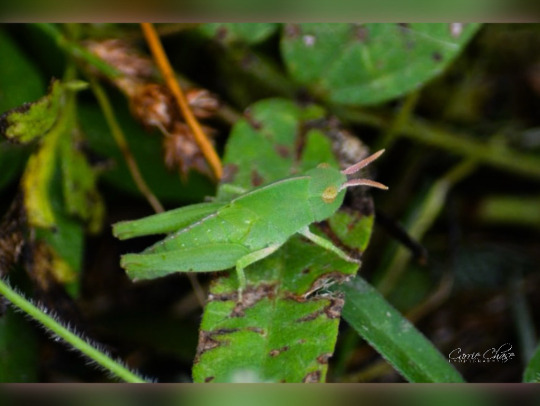
Green-striped Grasshopper
Chortophaga viridifasciata
Observed at Galveston Island State Park 6.12.25. The native range is from Canada to Costa Rica. They prefer grassy areas that are sunny yet moist. They mainly feed on the grass or forbs or flowering plant.
They can be green (usually female) or brown (usually male) and this is called color polymorphism.
They are one of the first grasshopper species to emerge in the spring from being eggs or larvae that overwintered.
The males are slightly smaller than the females. Females will have multiple broods per year, this was found to happen in the Southeastern US.
#Greenstripedgrasshopper #Chortophagaviridifasciata #citizenscience #native #grasshopper #insect #nature #outdoors #june #june30 #2025 #picoftheday #project365 #day181
7.1.25

Buffalograss
Bouteloua dactyloides
Observed in my parent’s backyard in Cleburne 6.19.25. Its native range extends from central Canada and down to Mexico and all through the central plains states of the US.
It gets its name, Buffalograss, from being the primary food source for buffalo in the past.
It is a drought tolerant grass that grows in the warm seasons. The root go deep which help it get through long periods without water. Those deep roots also help prevent soil erosion.
The male and female flowers grow on separate plants. The female flowers are hidden down low in the leaves and the male flowers stand out above and look like combs (pictured on the right).
#buffalograss #Boutelouadactyloides #citizenscience #native #grass #flora #nature #outdoors #july #july1 #2025 #picoftheday #project365 #day182
#citizen science#nature#outdoors#native#birds#fauna#laughing gull#metallic bluish-green cuckoo wasp#cuckoo wasp#insect#nonnative#invasive#cosmopolitan#chestnut bolete#fungus#mushroom#whitemouth dayflower#wildflower#flora#dayflower#green striped grasshopper#grasshopper#Buffalograss#grass
1 note
·
View note
Text
Pigeons could be nature's most disease-ridden animals!
When we think of pests spreading diseases, animals like flies, rats, or mice often come to mind. However, pigeons, sometimes called “rats with wings,” can pose significant health risks—especially when their populations grow in urban areas. Pest pigeons thrive by scavenging on sidewalks, bins, and other unsanitary areas, bringing them into contact with a range of pathogens that can be harmful to humans.
The Droppings Problem

A single pigeon produces over 11 kg of droppings each year, which can accumulate rapidly where pigeons roost or perch. These droppings are not only unsightly but corrosive, leading to structural damage over time. The most concerning issue, however, is their potential to carry disease.
Pigeon droppings host various pathogens that can be harmful if inhaled or accidentally ingested. The droppings often dry out and become powdery, which can easily spread through the air, particularly when disturbed. Regular accumulation increases the risk of exposure to several diseases, especially in urban areas.
Health Risks Associated with Pigeons
Pigeon droppings can carry diseases like:
Cryptococcosis: A lung infection caused by the Cryptococcus fungus, commonly found in pigeon droppings. Cryptococcosis can lead to meningitis and flu-like symptoms, especially in people with weakened immune systems.
Psittacosis: This bacterial infection, also known as parrot fever, is transmitted through exposure to pigeon secretions and droppings and can cause severe flu-like symptoms.

Histoplasmosis: Another respiratory disease caused by fungal spores in bird droppings, histoplasmosis can lead to severe lung infections.
Campylobacter and Salmonella: Pigeons can spread these bacteria, often through contaminated water or surfaces, causing gastrointestinal issues if ingested.
Prevention Through Effective Pest Control
Managing pigeon populations effectively is essential for both aesthetic and health reasons. While cleaning measures are helpful, they can only provide a temporary fix. For long-lasting results, a comprehensive pest control strategy is the best approach. By tackling the problem at its root—reducing pigeon nests sites and limiting food sources—you can mitigate the risk of disease spread and keep your environment safe.
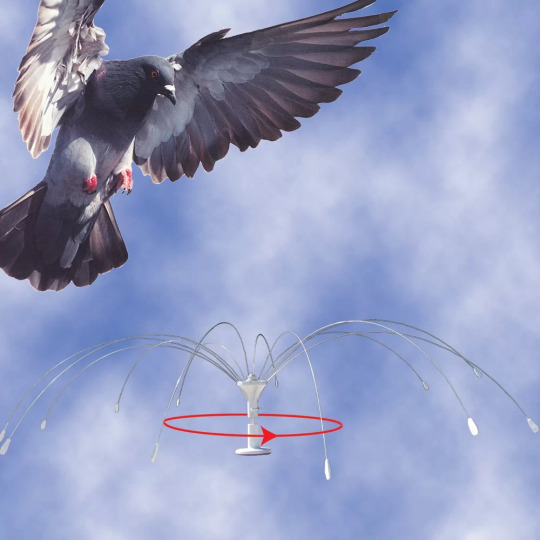
Our pest control services offer humane and effective bird control solutions to manage and prevent pigeon infestations, ensuring your property remains clean, safe, and free of harmful pathogens. Book a professional pest control service today to safeguard your home and health from the hidden risks posed by pigeons.
#PigeonControl#PigeonPestControl#BirdControl#PestManagement#UrbanPigeons#PigeonProblems#BirdProofing#PestPrevention#BirdDeterrent#GetRidofPigeons
0 notes
Text
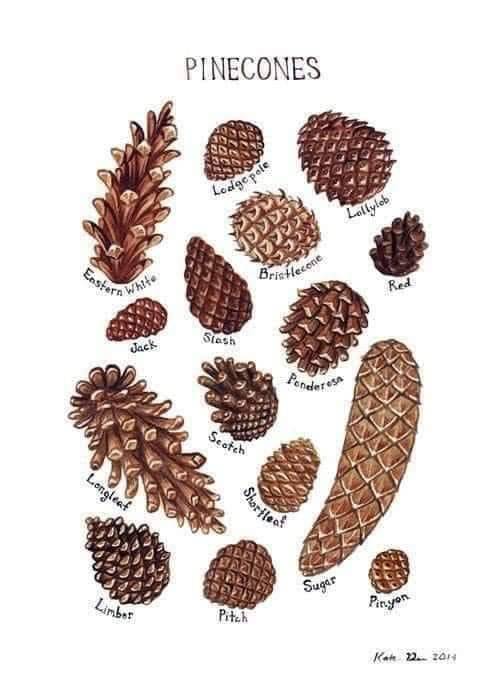
Pine cones and pine trees belong to a group of plants called gymnosperms and date back to prehistoric times.
Symbolism: Pine cones have been associated with enlightenment, resurrection, eternal life, and regeneration throughout history.
Traditional medicine: Chewing on a pinecone can help fight mouth infections, and young pinecones can be used to make a tea to treat skin infections
Help wildlife: Fallen pine cones can help wildlife through the colder months.
House Insects: Pine cones can work as a nesting spot for insects.
Bird feeder: You can make a bird feeder by tying a string to the top of a pinecone, rolling it in peanut butter, and sprinkling birdseed on top.
Mulch: Pine cones are a good mulch because they retain moisture, suppress weeds, and are resistant to mold and fungus. They are acidic and work well around plants that like acidic soil, like blueberries and azaleas.
Pinecone jam: A Georgian delicacy, pinecone jam is made by boiling soft baby pinecones in water with sugar. It's said to treat ailments like colds, bronchitis, and asthma.
Grow new pine trees: The seeds inside pine cones can be used to grow new pine trees.
Crafts: Pine cones can be used in a variety of crafts.
Decorations: Pine cones can be used to decorate your home. Wreath for the door. Garland above fireplace. Add ribbon for an ornament.
Air fresheners: Place your pine cones in a decorative bowl. Add a few drops of essential oils and use them as a natural air freshener.
Fire Starters: Pine cone fire starters are great if you are into camping or just enjoy a nice fire in the fire pit in the backyard.
Compost: Add them to your compost pile—they are a valuable source of carbon ('browns').
#pinecone#nature#balance#gymnosperms#symbolism#enlightenment#pineal gland#regeneration#traditional medicine#wildlife#craft#wicca#pagan#egyptian#egypt
0 notes
Text
6 Signs To Call For Tree Removal in Hollywood
Numerous homeowners take pleasure in the beauty and shade provided by trees on their property. However, what occurs when a tree transitions from an asset to a liability? Recognizing the opportune moment to engage Your Way Tree Service Inc. for expert tree removal in Hollywood is paramount for ensuring safety and tranquility. Here are the indicators to look out for that may signify the necessity of removing your tree.
The Dangers of a Dead or Dying Tree A dead or dying tree isn’t just an eyesore – it’s a safety hazard. Weakened by decay, a dead tree can fall unexpectedly, damaging your home, property, or even causing injury. Don’t wait for disaster to strike. Address the problem promptly with professional tree removal.
6 Telltale Signs Your Tree is in Trouble Fungus Among Us: Mushrooms or other fungi growing at the trunk’s base or on the tree itself often signal decay and potential danger. Barking Up the Wrong Tree: Chipped, peeling, or cracked bark indicates underlying problems that could compromise the tree’s structural integrity. Cavity Concerns: Large holes or cavities in the trunk or major limbs weaken the tree and invite further damage from pests and disease. Deadwood Dilemma: Dead or hanging branches pose a risk of falling and should be addressed promptly. In some cases, removing the affected branch might save the tree, but often, the entire tree needs removal. Leafless in Spring: If large sections of your tree fail to produce leaves or buds in the spring, it’s likely dead or dying and should be assessed for removal. Dry and Dark Bark: Scratching the bark to reveal dark or dry wood underneath indicates a lack of vitality and could mean the tree is beyond saving.
Enhancing Property Value, Environment, and Well-Being Did you know that a healthy tree can significantly increase your property value? Studies show that mature trees can boost your home’s worth by up to 15%. Beyond aesthetics, trees offer tangible benefits like energy savings through shade and wind protection. Plus, they create a natural habitat for local wildlife, contributing to the biodiversity of Hollywood’s unique ecosystem.
And it’s not just about finances and the environment. Trees also enhance our well-being. Research indicates that spending time in nature, surrounded by trees, reduces stress, improves mood, and even boosts creativity. Whether it’s the joy of watching birds nesting in your backyard or simply enjoying the shade on a hot day, trees bring a sense of peace and tranquility to our lives. So, while removing a dangerous tree is crucial for safety, remember that healthy trees are an investment in your property, your community, and your own happiness.
DIY Tree Removal? Think Again! Removing a tree yourself is dangerous and requires specialized tools and expertise. Leave it to the professionals. A licensed, trained tree removal expert will safely and efficiently remove the tree, protecting you and your property.
Warning Signs on Your Hollywood Trees? Contact Your Way Tree Service Inc. For any signs of concern on your Hollywood tree, act promptly. Reach out to Your Way Tree Service Inc. today for expert tree removal in Hollywood to safeguard your property’s beauty and safety.
You can schedule a free consultation by visiting our website now.
0 notes
Text
the complex liminal nightmare of extinction can be for everyone now
When you’re uncertain what you’re looking at, the catastrophic footprint of the beetle called the Agrilus planipennis Fairmaireis doesn’t really resemble a crisis. Perhaps it’s a fungus? Some genetic anomoly in the patterning and color of the ash tree’s bark?—maybe a blight at worst… Something like a pale vegetal rash.
Then you might notice how many of these trees are lying dead and dry among so many other thriving species. When you look closer, you notice half of the ash trees you’re passing have been cut off at the stump, perhaps still lying where they fell.
When it hits you and you realize they are dying of some sort of disease innate to the ash, it’s impossible to avoid pivoting immediately to the dire numbers literally surrounding you.
In the lowland forests below the bluffs of the driftless, I have walked with a sinking feeling. A forest of blighted corpses. Not a single ash in sight without some obvious symptom of the infection. In a woods below the bluffs I stood surrounded by a swift extinction. I could touch it. See it scattered everywhere. It was marked in blue spraypaint. But as horrifying as it was to behold at that moment I know the strange liminal nature of extinction now—because it was the thought of this forest ten years in the future that made me feel hopeless, that turned the pit in my guts rancid.
The beetle comes and does its thing. Then it leaves and the forest is devastated. Every last ash dead or proactively cut down. And then the cascade of death actually begins. Any dependent species will fade quickly. In the cedar—ash muskegs north of the Mississippi’s headwaters, the loss of the ash trees would mean a rapid shift in the understory. Shifts in animal and bird species. In the same region, lake shores would be rapidly and dramatically altered, and the growing bald eagle population would lose critical nesting grounds. From Minnesota’s wild rice habitats to the mountains of Appalachia where mixed forest habitats would be equally ravaged, the total loss of ecological balance cannot be comprehended nor computed in the present.
The emerald ash borer extinction event is a nightmare playing out in silent eminations and formlessness, liminal agonies, networks of loss in which a single species of beetle—ordinary in its original habitat—can no longer be comprehended as such.
This is not an isolated event. Extinctions are occurring for reasons appallingly similar in the python-infested Everglades. While technocratic liberalism and the moralizing laptop class fed everyone else to the climate gods, their children ordered exotic pets on a corporation called Amazon, became bored with them, and stupidly and fatefully released them into already vulnerable habitats. Very real individuals are very much responsible for North America’s countless imploding ecologies, and they aren’t evil industrials cracking whips inside factories. The simple stupid greed of a nice suburban family, as it turns out, can be just as catastrophic as a thousand logging crews.
1 note
·
View note
Text
FOTD #024 : dung-loving bird's nest! (cyathus stercoreus)
the dung-loving bird's nest (what a name !!) is a fungus in the family nidulariaceae. it grows worldwide, & is most often found in animal dung.
the big question : can i bite it?? while inedible, this fungus is used in both traditional medicine & biodegradation.

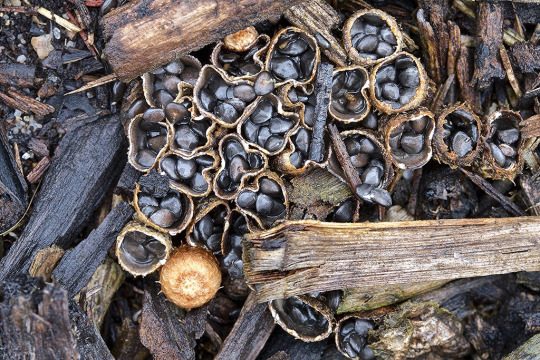
c. stercoreus description :
"the fruiting bodies, or perida, are funnel- or barrel-shaped, 6–15 mm tall, 4–8 mm wide at the mouth, sometimes short-stalked, golden brown to blackish brown in age. the outside wall of the peridium, the ectoperidium, is covered with tufts of fungal hyphae that resembles shaggy, untidy hair. however, in older specimens this outer layer of hair (technically a tomentum) may be completely worn off. the internal wall of the cup, the endoperidium, is smooth and grey to bluish-black. the 'eggs' of the bird's nest – the peridioles – are blackish, 1–2 mm in diameter, & there are typically about 20 in the cup. peridioles are often attached to the fruiting body by a funiculus, a structure of hyphae that is differentiated into three regions: the basal piece, which attaches it to the inner wall of the peridium, the middle piece, & an upper sheath, called the purse, connected to the lower surface of the peridiole."
[images : source & source] [fungus description : source]
"little freak </3 i love him. be gross like that."
#• fungus of the day !! •#[cyathus stercoreus]#: dung-loving bird's nest :#024#||#fungi#mycology#fungus#mushrooms#earth#cottagecore#forestcore#mushroom#foraging#nature#cyathus stercoreus#dung-loving bird's nest
39 notes
·
View notes
Text
OKAY SO I FORGOT TO FINISH THIS POST but basically a few days ago i was wandering the Locations and came across this tree, ive been familiar with it for years but this time i saw something fleeting and incredible:

A BIRDS NEST FUNGUS
Growing out of the dead outer bark layer!
I've only seen these once before; an almost steely dark species growing on the ground near the chicken run. The irony of seeing a birds nest fungus *in a tree* is also pretty lovely.
The funnel-shape of the nest and the "eggs" inside are a part of its dispersal method. A raindrop falls into the cup, and splashes the spore packets up the sides and outwards.
Anyways, i kept looking at this tree, and saw something else cool. Among the incredible variety of colors from reds to greens to grays and everything in between, there are these black lines snaking through the bark fibers
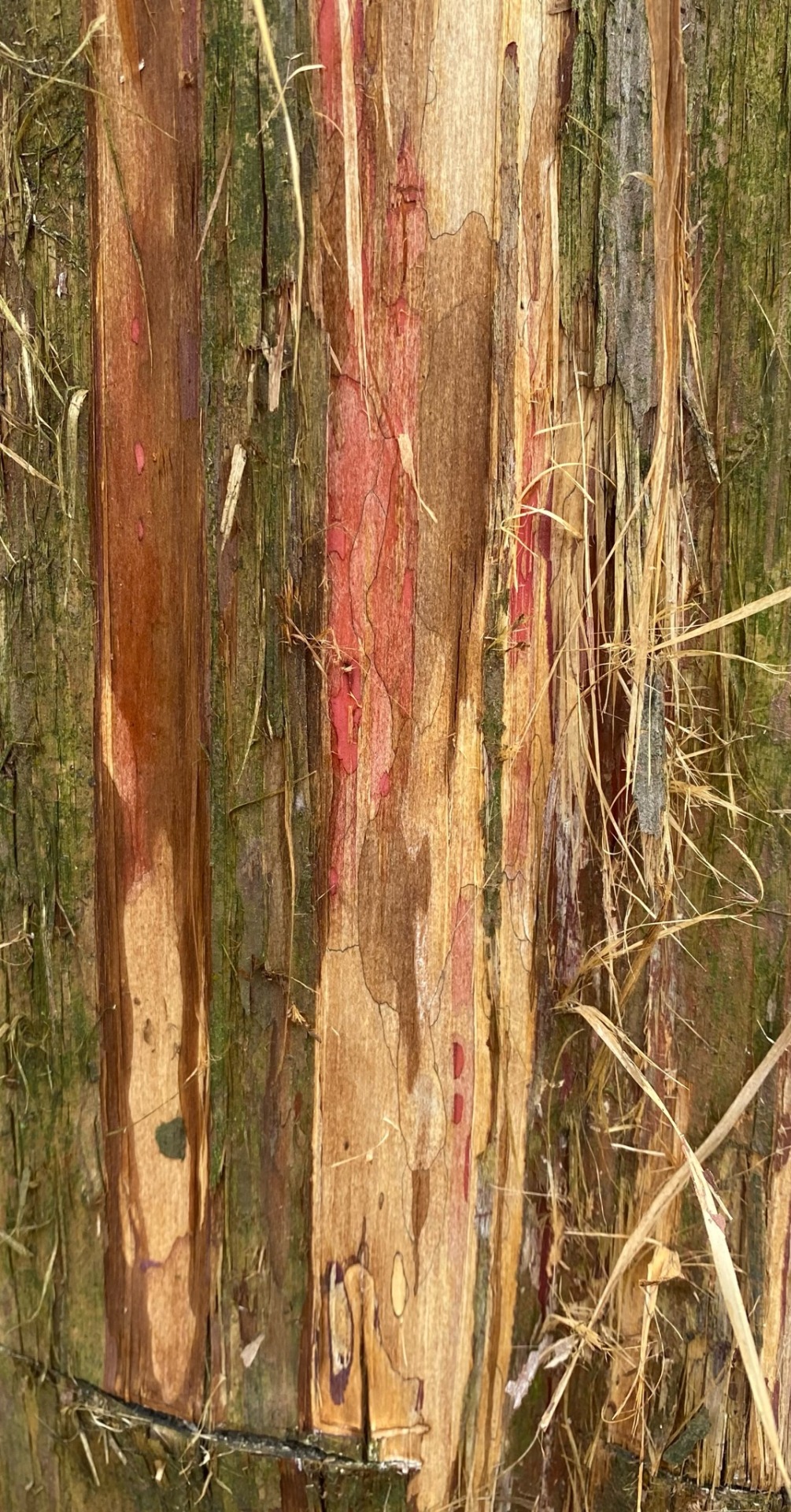
Faint, almost hairlike. These are called Zone Lines and are the defensive barriers put up by fungi as they spread and need to defend their resources from other fungi. When it occurs in wood, it's known as spalting, and can be quite beautiful when carved.
This made me think of what i've heard about zone lines from folks while going on nature walks, and i remembered there's this area of wood that looks a lot like one i've heard discussed.
Basically, if you picture a log, with different fungi growing on it, you end up with a 3D matrix of zone borders all intersecting in unique patterns. Some fungi burn out quickly, eating into the wood and turning it into spores and dirt and crumble away; all the while there are other fungi that are secluded in their whimsical 3D shapes long past the decay of the other fungi.
What do these look like? Something like this:
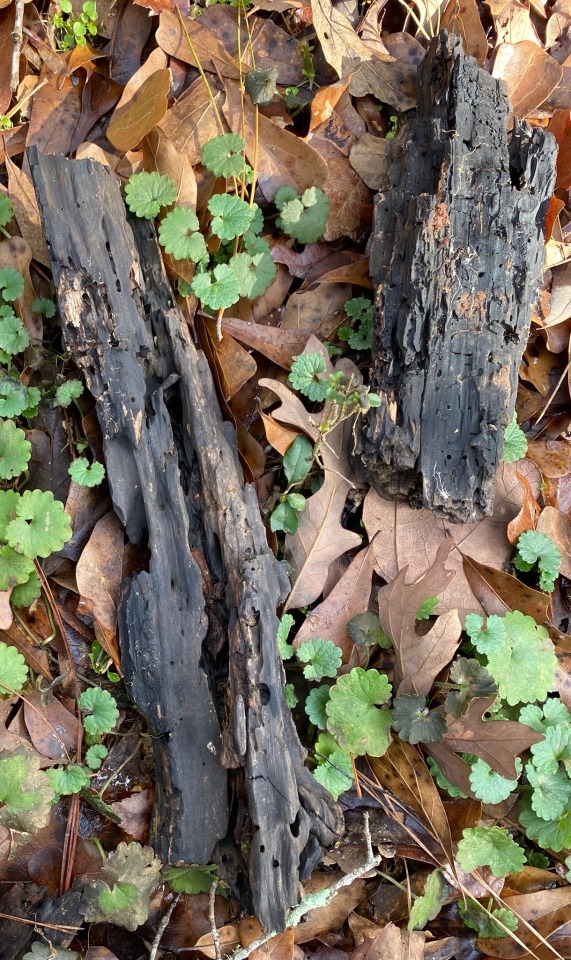
three dimensional zone lines! A dark black/brown matte surface keeping the fungus defended as it chugs along slowly, breaking down its territory staked out long ago
Breaking open the wood shows this border/digestion area distinction:

I've got no idea how long this particular variety takes to decay. I've seen this wood here for years just like other rotting logs, but it was only about a year ago that i learned what makes it look the way it did!
Something that *was* new to me was this, though:
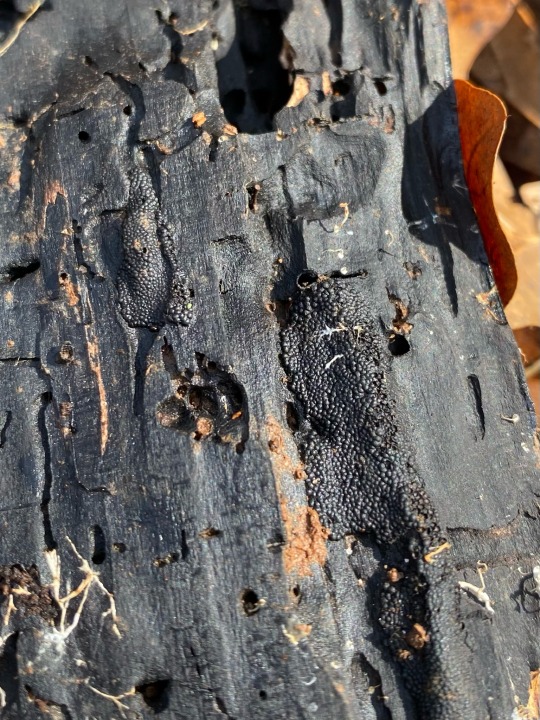
I saw this strange pattern of speckles, almost bubbly, scaly looking patches underneath the barrier. I havent seen this before, nor do i know what it is. Maybe it's the fruiting body of this particular fungus. Maybe it's a defensive wall put up against some foreign invader. Maybe it's a holdover from something in the life of the tree that the fungus simply grew over.
Whatever it is, it's quite fascinating.
This all made me go look for other cool decomposition patterns. I came across this whiterot oak branch that had fallen. Rotted oak like this is great for giving to rolly pollies as a snack, especially when very crumbly. But this time i was interested in the almost imperceptible hairs snaking through it as well:

it hides quite well in this branch, especially because the walls like to form in alignment with the wood's natural grain. But running through the center from top to bottom there *is* a zone line.
it's slightly more visible from the top, where you can also see the slight color difference between the two zones thanks to the different chemical compositions/byproducts of the competing fungi

It really is just so cool. wars raged beneath our feet in branches we may throw aside or even burn.
Here's an old post oak stump; for a few years it's been here and we used to use it as a surface for splitting firewood. now large channels have rotted away and the surface has taken on that dark fungal look.
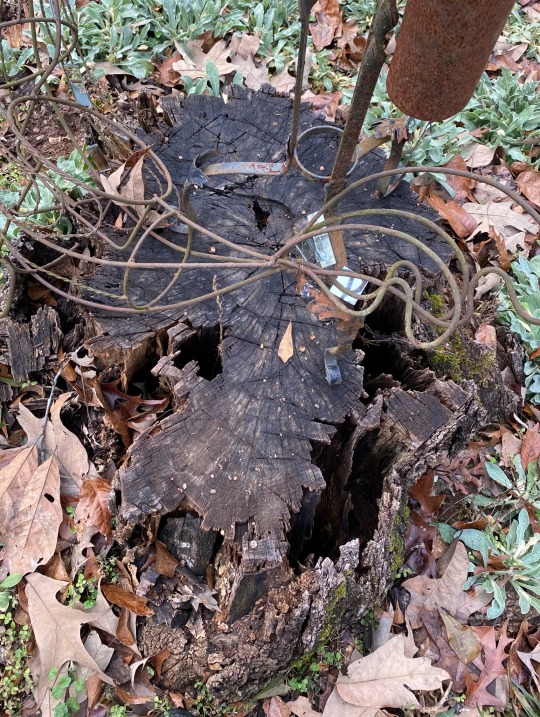
this final pic is down one of the channels that's decayed into the tree. It appears that all the elements of water, bugs, fungus, *decay* have all hollowed out a matrix that follows along down into the tree roots themselves.
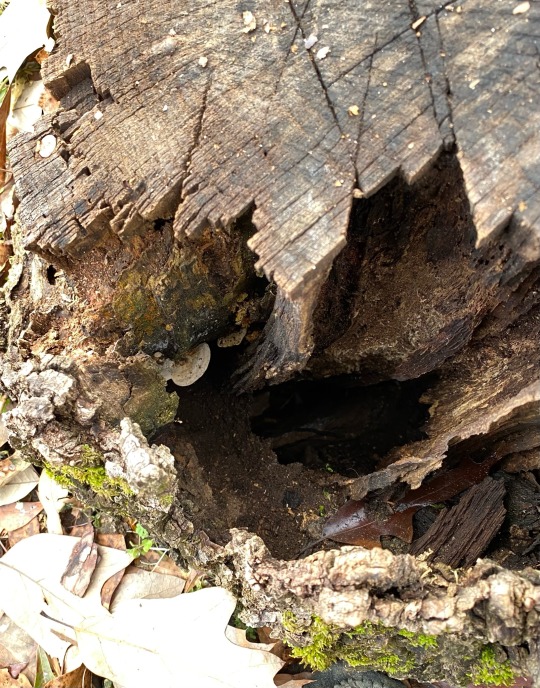
It's a lot deeper than the ground surface. I've seen chipmunks go in and out of it as well. I can only imagine there's a whole luxury burrow complex down there.
Some pretty interesting stuff to see out there. Hope this was a good summary!
4 notes
·
View notes
Photo
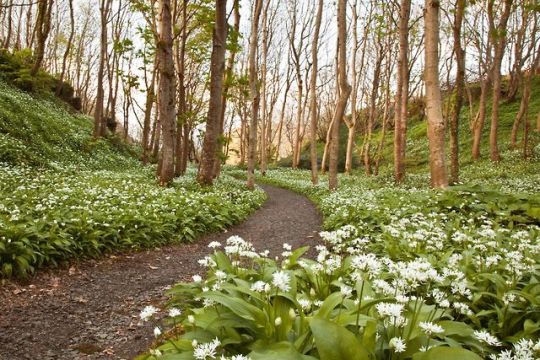
The Wood-Path - Madison Julius Cawein
Here doth white Spring white violets show, Broadcast doth white, frail wind-flowers sow Through starry mosses amber-fair, As delicate as ferns that grow, Hart's-tongue and maiden-hair.
Here fungus life is beautiful, White mushroom and the thick toad-stool As various colored as wild blooms; Existences that love the cool, Distinct in rank perfumes.
Here stray the wandering cows to rest, The calling cat-bird builds her nest In spice-wood bushes dark and deep; Here raps the woodpecker his best, And here young rabbits leap.
Tall butternuts and hickories, The pawpaw and persimmon trees, The beech, the chestnut, and the oak, Wall shadows huge, like ghosts of bees Through which gold sun-bits soak.
Here to pale melancholy moons. In haunted nights of dreamy Junes, Wails wildly the weird whippoorwill, Whose mournful and demonic tunes Wild woods with phantoms fill.
79 notes
·
View notes